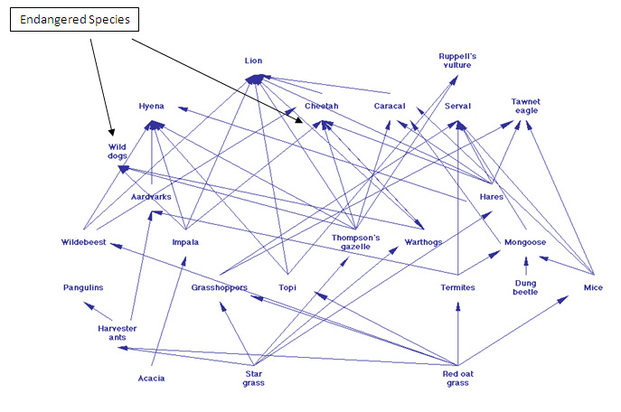African Savanna- Serengeti Plains
Wildlife

The Serengeti is obviously most famous for its migration. It is home to many species, including the “Big Five”, which were large hunted animals. These included lions, leopards, rhinos, Cape buffalo, and elephants. These animals are not protected, though, and are only “hunted” through camera lenses.
The Serengeti migration is famous for its sheer size of animals that pass through. In October and
November, over a million wildebeest and hundreds of thousands of zebras migrate south for the short rains. And then they swirl west and north after the long rains from April to June. The migration has occurred for millions of years such that the instinct to migrate has ingrained within them. It is said that the instinct is so strong that no drought, gorge or crocodile infested river can hold them back.
For a full list of animal species found in the Serengeti, please go here: http://www.serengeti.org/animals.html
The Serengeti is mostly made of grassland, woodland, plains, kopjes, and marshes, which all contribute to make the savanna. One of the most common features of the savanna is fire. The sheer number of animals found on the Serengeti requires nutrient replenished soil, which can only come from fires. The potential to burn causes the savanna to have a very dynamic landscape. Succession, thus, is extremely important in studying the Savanna.
Some of the plant species found in the savanna is Red Grass, which is a long-grass. It gets its name from the dark reddish color as it dries. The grass grows in a dense bunch, but through the long-grass plains, it grows widely spaced like fields of wheat. The Wildebeest feed on Red Grass, although not primarily. Short grasses include Pan Dropseed and Digitaria macroblephora. Both grow in dwarf form, which makes it difficult to identify. The hard pan layer in the soil, in addition to the massive herbivory combine to produce the abundance of smaller grasses such as these.
Since the Serengeti is essentially the most diverse area on the planet, it would be a shame to see it disappear. It is home to one of the last remaining migration cycles. It biodiversity is among the highest found anywhere, and it is one of the few places left on Earth relatively untouched by industrialization. The Serengeti is a sacred place not only for the animals, but also for its human inhabitants, who live alongside in harmony.
The Serengeti migration is famous for its sheer size of animals that pass through. In October and
November, over a million wildebeest and hundreds of thousands of zebras migrate south for the short rains. And then they swirl west and north after the long rains from April to June. The migration has occurred for millions of years such that the instinct to migrate has ingrained within them. It is said that the instinct is so strong that no drought, gorge or crocodile infested river can hold them back.
For a full list of animal species found in the Serengeti, please go here: http://www.serengeti.org/animals.html
The Serengeti is mostly made of grassland, woodland, plains, kopjes, and marshes, which all contribute to make the savanna. One of the most common features of the savanna is fire. The sheer number of animals found on the Serengeti requires nutrient replenished soil, which can only come from fires. The potential to burn causes the savanna to have a very dynamic landscape. Succession, thus, is extremely important in studying the Savanna.
Some of the plant species found in the savanna is Red Grass, which is a long-grass. It gets its name from the dark reddish color as it dries. The grass grows in a dense bunch, but through the long-grass plains, it grows widely spaced like fields of wheat. The Wildebeest feed on Red Grass, although not primarily. Short grasses include Pan Dropseed and Digitaria macroblephora. Both grow in dwarf form, which makes it difficult to identify. The hard pan layer in the soil, in addition to the massive herbivory combine to produce the abundance of smaller grasses such as these.
Since the Serengeti is essentially the most diverse area on the planet, it would be a shame to see it disappear. It is home to one of the last remaining migration cycles. It biodiversity is among the highest found anywhere, and it is one of the few places left on Earth relatively untouched by industrialization. The Serengeti is a sacred place not only for the animals, but also for its human inhabitants, who live alongside in harmony.
